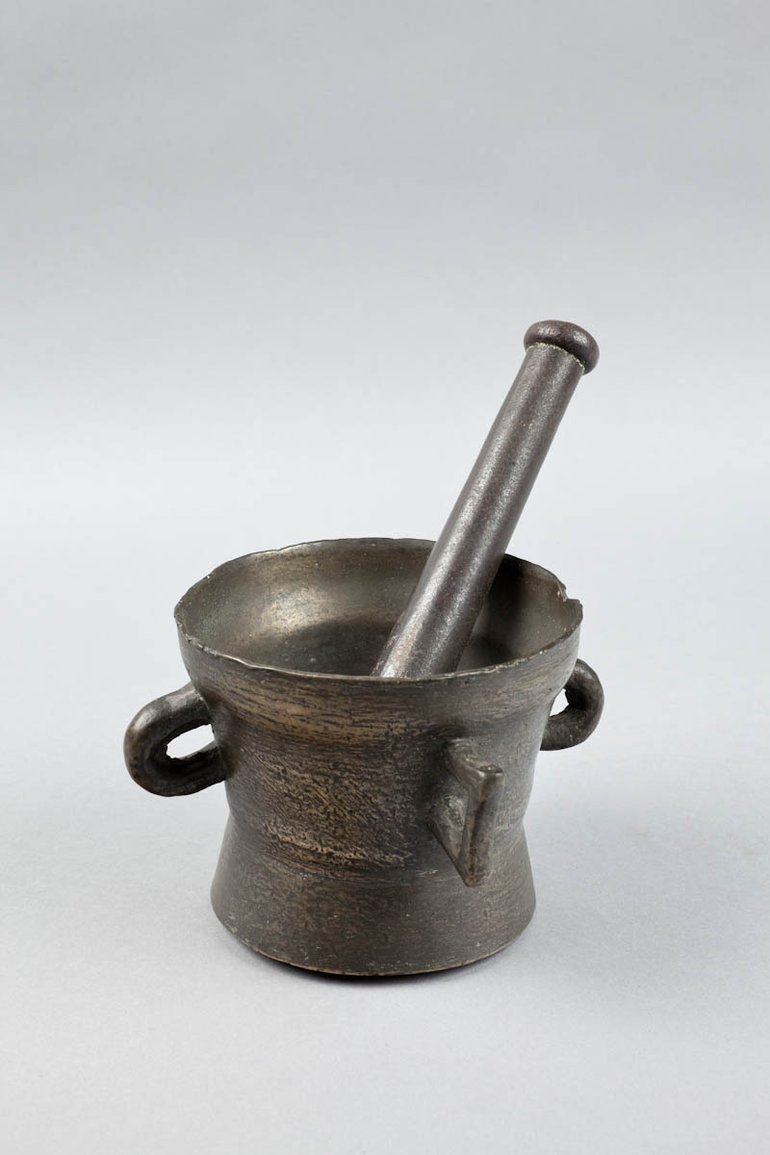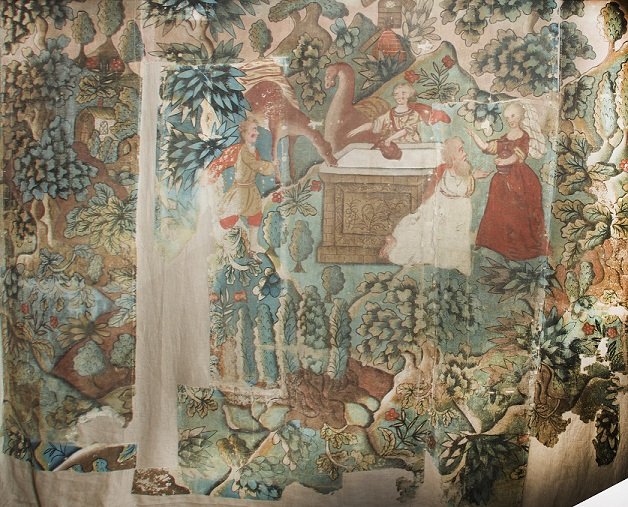Alex is a Research Associate for the Middling Culture project and a PhD student in History at the University of Birmingham in which she is funded by the Arts and Humanities Research Council: Midlands3Cities.
When William Shakespeare purchased his gentry home - New Place - in 1597, he likely made some substantial improvements. As a new member of the gentry, he was expected to display his status to the great and good of Stratford-upon-Avon, and a home renovation project provided the perfect opportunity. By using a combination of archaeology, documents and surviving buildings, we can say more about how Shakespeare might have furnished and decorated his home, and, significantly, what this tells us about self-fashioning more broadly in the 16th and 17th century.
But it is important to remember that Shakespeare did not live alone in this grand townhouse. His children Susannah and Judith, his wife Anne and possibly his parents also lived in this large property at one time or another. Little evidence remains for these additional residents and their experiences of New Place. But they all had an impact on the function and furnishing of this property. None so much as the mistress of the household, Anne Shakespeare (née Hathaway). Anne would have been in charge of running New Place - its maintenance, household production and consumption. Her experience and use of the house would have been different from her husband’s, but her influence over its day-to-day running was no less significant. We have no way of knowing Anne’s experience of the interiors of New Place, but we can look for evidence of similar women and their homes within the town through their wills and inventories (Appleton, 2015; Orlin, 2014).

In March 1596 a lady called Anne Hiccox of Stratford-upon-Avon passed away and all her possessions were recorded in an inventory (BRU 15/5/81). The appraisers moved through her home taking stock of the various objects found within each room. ‘A longe table and a square table’, fruit dishes, candlesticks and ‘a spice mortar of brasse’ were discovered in the hall. Painted cloths, stools, napkins, sheets, a bed, chair and a sword could be found in the ‘parlour joining to the hall’. In the shop and ‘cutting house’ a variety of silverware, a desk, coffer and tools were also valued. Other items relating to domestic life, work and clothing were dispersed throughout the remaining spaces of her home. Traces of Anne Hiccox’s domestic life and experiences are discovered throughout this document. The sum total of the goods listed tells us that she was a fairly wealthy woman. Six months a widow, her husband William rather unusually left her the entire house and its contents. Or it may have been that appraisers waited to complete an inventory of the house after the successive deaths of William and Anne. Either way, this house was substantial. It contained a hall, parlour, shop and buttery, with five rooms on the floor above and a number of outhouses.

Anne Hiccox therefore resided in a fully furnished house at the time of her death. In the (short) period between her passing and that of her husband’s, she had a chance to put her own mark on the property. Of course, her influence over these interiors may always have been significant, but legally the house and everything in it had belonged to her husband while he was alive (under the legal practice of coverture). The painted cloths, bedding and even the wainscot (wooden wall panelling) mentioned throughout the inventory may well have been chosen by Anne Hiccox, but they would have been purchased by her husband.
Widows were among the few single women legally entitled to own property in early modern society. As a result, they often left behind an inventory. Upon a husband’s death, a widow might be gifted domestic goods and/or an allowance. They were also entitled to some form of accommodation to be provided through their husband’s estate. Often the house or its lease would be sold, with the proceeds going towards an allowance. Sometimes, if the house remained within the family, widows were only permitted the use of a single space (usually a parlour), with any heir and their family occupying the rest of the property (Orlin, 2016).

But some middling women prospered as widows. Wives sometimes inherited all of their husband’s assets (his land, property and possessions), especially if there was no male heir. This might include a business (or goods relating to a trade) as well as the house and all its contents. Like Anne Hiccox, these women often left behind detailed inventories of their own. These documents reveal the wealth and status bestowed upon some widows. Anne Hiccox’s husband appears to have left her his tools and goods from his trade as a tailor. Some widows continued to run the family business after their husband’s death, or they may even start their own.
Historian Stephanie Appleton has revealed the wide-ranging business transactions that widows in early modern Stratford seemed to be involved in. Through her study of wills in the 16th and 17th century, she has uncovered the entrepreneurial lives of middling townswomen. Many widows in Stratford were making generous sums as money lenders, among other enterprises like the production of malt for brewing. Such information can often be found in wills or inventories, through items or goods relating to those industries. If we keep in mind the context in which these sources were created, we can learn a great deal about the domestic lives and possessions of such women.

What, then, can we learn about Anne Hathaway? As Shakespeare’s fortune and status grew, so did Anne’s. In 1597 she became mistress of one of the largest properties in Stratford-upon-Avon. She likely managed some servants, as well as caring for her children and possibly her in-laws. As with other women in the town, Anne was probably involved in the household’s production and consumption. This is demonstrated in inventories left behind by other widows of the town. Buckets, barrels and looms are items with which the women of the house were very familiar. Indeed, anything from the production of food, beer, textiles to the purchasing of household goods were likely Anne’s responsibility.

Anne had been a widow for seven years by the time she died in 1623 and, sadly, her will and inventory no longer remain. We do not know where she resided during this time but she probably remained at New Place. She would have had specific use of at least one room, if not the whole house. From Shakespeare’s will, we know that she was left ‘the second-best bed’, possibly the bed that they had shared together. But in the end New Place and all its ‘Appurtenances’ (accessories or furnishings) went to William and Anne’s eldest daughter, Susanna, and her husband John Hall. Other than the ‘second best bed’, this probably meant that Anne did not legally own any of the household goods in New Place. But she might have had a small number of items that she brought to the marriage, which would have remained her property after William’s death. Perhaps she had a small collection of clothing, dining ware, books and production items like Anne Hiccox. Almost certainly she would have possessed textiles and soft furnishings such as napkins, table cloths and bed linen, albeit they may have been a little worn by the time she died. Nonetheless, Anne would have been the legal owner of a number of domestic goods that could be used to furnish whichever rooms she occupied as a widow in New Place. Would she have kept the fixed decoration installed while her husband was alive - the wall paintings, panelling and plasterwork - or would she have made her own adjustments to the rooms she now lived in? As with Shakespeare, we will never know Anne’s impact on the interiors of New Place but we can consider evidence left behind by others to begin to build a picture.
Further Reading
For more information on Anne Hathaway’s life, property and entrepreneurship, based on comparable evidence, see Lena Cowen Orlin, ‘Anne by Indirection’ Shakespeare Quarterly vol. 65 (2014), pp. 421–54
For more on widows’ inventories and room rights, see Lena Cowen Orlin, 'Rights of Privacy in Early Modern English Households' in Catherine Richardson, Tara Hamling and David Gaimster (eds), The Routledge Handbook of Material Culture in Early Modern Europe (2016), pp.423-435
For information on widows in early modern Stratford-upon-Avon, see Stephanie Appleton, ‘Women and Wills in Early Modern England: The Community of Stratford-upon-Avon 1537 – 1649’, PhD Diss., University of Birmingham (2016)
For insights into women and property rights, see Amy Louise Erickson, Women & Property In Early Modern England (London, 1993)
For details on production and consumption in the early modern household, see Mark Overton, Jane Whittle, Darren Dean, and Andrew Hann, Production and Consumption in English Households, 1600-1750 (Abingdon, 2004)
Transcriptions of the inventories mentioned in this article can be found in Jeanne Jones (ed.), Stratford-upon-Avon Inventories, 1538-1699, Vol. 1, (The Dugdale Society in association with The Shakespeare Birthplace Trust, 2002)
